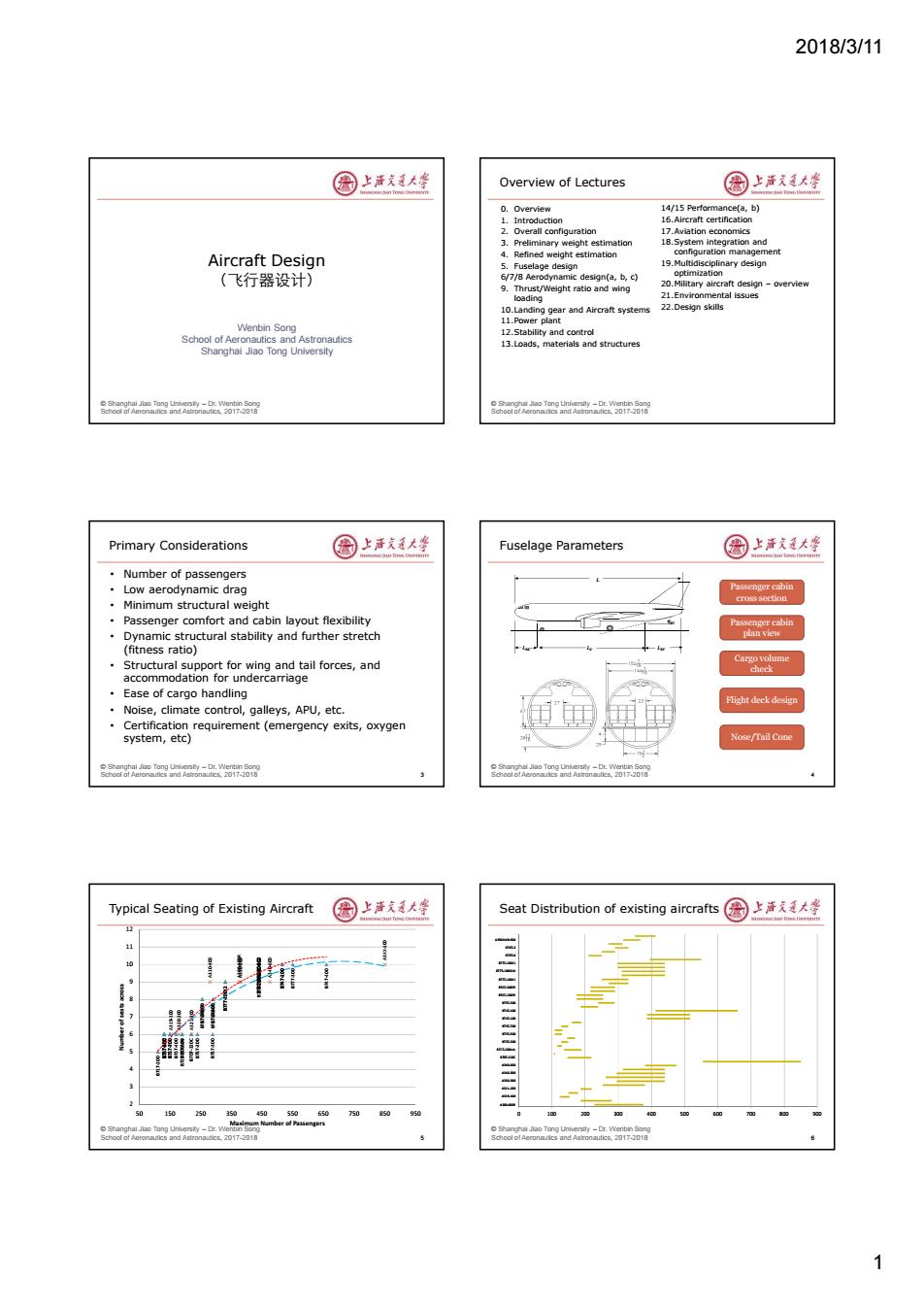
2018/3/11 国上活大坐 Overview of Lectures 国上清大学 0.Overview 14/15 Performance(a,b) 16.Aircraft certification 2.Overall configuration 17.Aviation economics 18.System integration and d weight estimation coafiauraticn management Aircraft Design Fuselage design 19.Multidisciplinary design (飞行器设计) 6/7/8 Aerodynamic design(a,b,c) ootimization .hat and ing 20.Military aircraft design-overview 21.Environmental issues 10.Landing gear and Aircraft systems 22.Desian skills Wenbin Song 11.Power plant School of Aeronautics and Astronautics 12.Stability and control Shanghai Jiao Tong University 13.Loads,materials and structures r nd 7 Soor an0 Primary Considerations 国上活大峰 Fuselage Parameters 园上活道大整 Number of passengers ·Low aerodynamic drag Passenger cabin Minimum structural weight Passenger comfort and cabin layout flexibility Passenger cabin Dynamic structural stability and further stretch plan view (fitness ratio) Structural support for wing and tail forces,and accommodation for undercarriage Ease of cargo handling Flight deck design Noise,climate control,galleys,APU,etc. Certification requirement(emergency exits,oxygen system,etc) NosefTail Cone eagaea2-w58 8oa6o0e四k-a88 Typical Seating of Existing Aircraft 园上洋天通大学 Seat Distribution of existing aircrafts上ǐ克t大Y 11 11 9 7 50 150250350450550650 750 850 950 sy -Dr.W Schoo of and Aronau2017-18 1
2018/3/11 1 © Shanghai Jiao Tong University – Dr. Wenbin Song School of Aeronautics and Astronautics, 2017-2018 Aircraft Design (飞行器设计) Wenbin Song School of Aeronautics and Astronautics Shanghai Jiao Tong University © Shanghai Jiao Tong University – Dr. Wenbin Song School of Aeronautics and Astronautics, 2017-2018 Overview of Lectures 0. Overview 1. Introduction 2. Overall configuration 3. Preliminary weight estimation 4. Refined weight estimation 5. Fuselage design 6/7/8 Aerodynamic design(a, b, c) 9. Thrust/Weight ratio and wing loading 10.Landing gear and Aircraft systems 11.Power plant 12.Stability and control 13.Loads, materials and structures 14/15 Performance(a, b) 16.Aircraft certification 17.Aviation economics 18.System integration and configuration management 19.Multidisciplinary design optimization 20.Military aircraft design – overview 21.Environmental issues 22.Design skills © Shanghai Jiao Tong University – Dr. Wenbin Song School of Aeronautics and Astronautics, 2017-2018 Primary Considerations • Number of passengers • Low aerodynamic drag • Minimum structural weight • Passenger comfort and cabin layout flexibility • Dynamic structural stability and further stretch (fitness ratio) • Structural support for wing and tail forces, and accommodation for undercarriage • Ease of cargo handling • Noise, climate control, galleys, APU, etc. • Certification requirement (emergency exits, oxygen system, etc) 3 © Shanghai Jiao Tong University – Dr. Wenbin Song School of Aeronautics and Astronautics, 2017-2018 Fuselage Parameters 4 LNC L LC LTC qTC Passenger cabin cross section Passenger cabin plan view Cargo volume check Flight deck design Nose/Tail Cone © Shanghai Jiao Tong University – Dr. Wenbin Song School of Aeronautics and Astronautics, 2017-2018 Typical Seating of Existing Aircraft 5 A310-300 A300-600R A319-100 A320-200 A321-200 A330-200 A330-300 A340-200 A340-300 A340-500 A340-600A3XX-100 B707-320C B717-200 B727-200Adv B737-200 B737-500 B737-600 B737-300 B737-700 B737-400 B737-800 B747-100 B747-200 B747-400 B757-200 B757-300 B767-200 B767-200ER B767-300 B767-300ER B777-100X1 B777-100X2B777-200 B777-200IGW B777-200X1 B777-200X2 B777-300 2 3 4 5 6 7 8 9 10 11 12 50 150 250 350 450 550 650 750 850 950 Number of seats across Maximum Number of Passengers © Shanghai Jiao Tong University – Dr. Wenbin Song School of Aeronautics and Astronautics, 2017-2018 Seat Distribution of existing aircrafts 6 0 100 200 300 400 500 600 700 800 900 A300-600R A319-100 A321-200 A330-300 A340-300 A340-600 B707-320C B727-200Adv B737-300 B737-500 B737-700 B747-100 B747-400 B757-300 B767-200ER B767-300ER B777-100X2 B777-200IGW B777-200X2 B787-8 B787-3 A350XWB-900
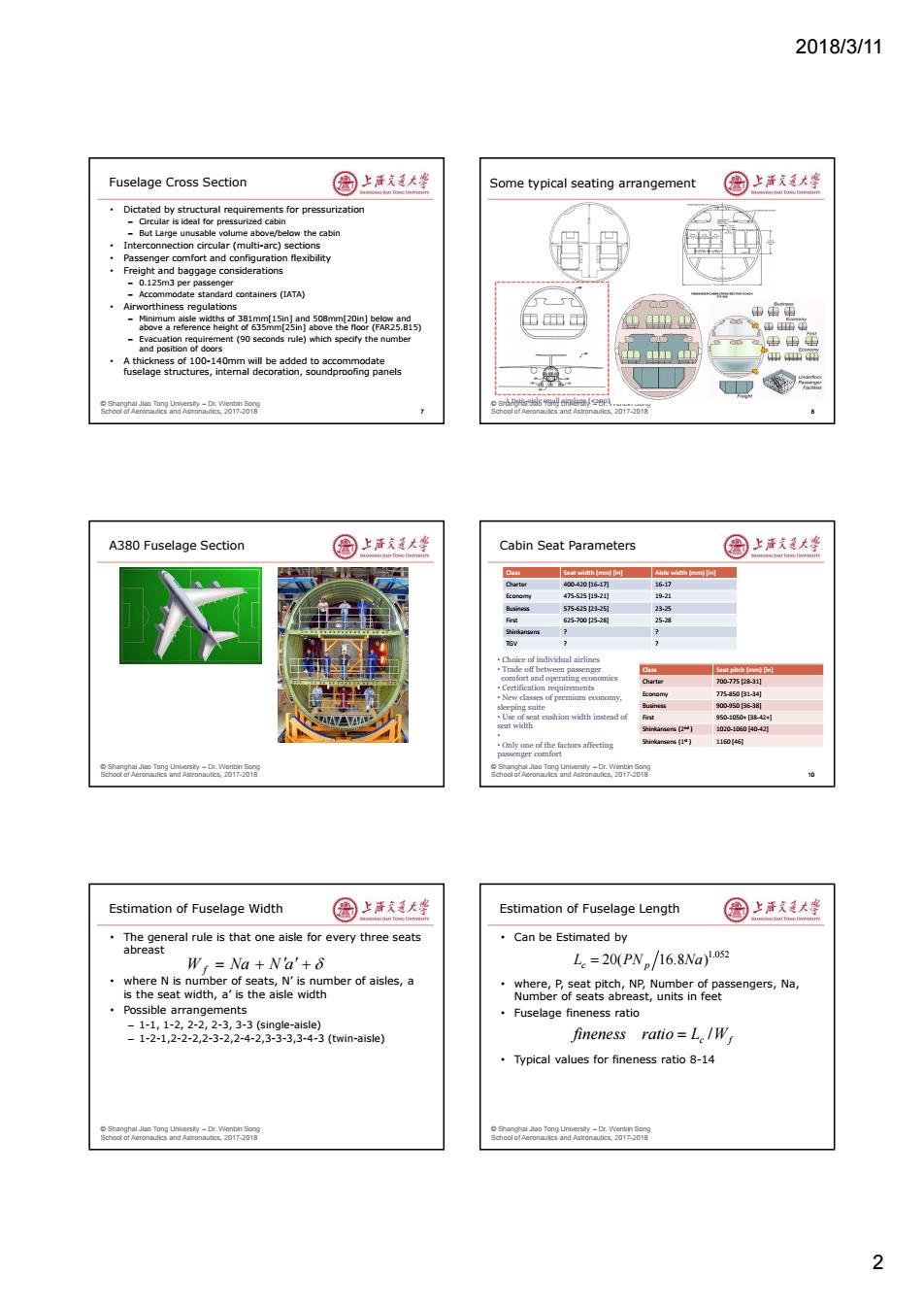
2018/3/11 Fuselage Cross Section 国上活大坐 Some typical seating arrangement 国上清大学 Dictated by structural requirements for pressurization is ideal for press ie l thecai Interconnection circular (multi-arc)sections Passenger comfort and configuration flexibility Freight and baggage considerations -0.125m3 per passenger -Accommodate standard containers (IATA) Airworthiness regulations 由雷量 团团 ,母耶 -Evacuation requirement(90 seconds rule)which specify the number 田田虽 and position of doors A thickness of 100-140mm will be added to accommodate 中富 fuselage structures,internal decoration,soundproofing panels 盘g A380 Fuselage Section 圈上活大坐 Cabin Seat Parameters 国上活支大峰 Saat width (mits finl swh时m 400420h6-17 16-17 475525H9-21] 19-21 55-65p4-2 625-7005-2图 7 .Choice of individual airlines Seat pech (m)in 700-77528-31 775950B1-34 900950B5-381 ushion width instead of 020-105014042 11506 rAer Estimation of Fuselage Width 国上清大学 Estimation of Fuselage Length 园上海发大坐 The general rule is that one aisle for every three seats Can be Estimated by abreast W r=Na+Na'+8 L.=20(PN/16.8Na)02 where N is number of seats,N'is number of aisles,a where,P,seat pitch,NP,Number of passengers,Na, is the seat width,a'is the aisle width Number of seats abreast,units in feet Possible arrangements Fuselage fineness ratio -1-1,1-2,2-2,2-3,3-3(single--aisle) -1-2-1,2-2-2,2-3-2,2-4-2,3-3-3,3-4-3(twn-aisle) fineness ratio =Le/W Typical values for fineness ratio 8-14 2
2018/3/11 2 © Shanghai Jiao Tong University – Dr. Wenbin Song School of Aeronautics and Astronautics, 2017-2018 Fuselage Cross Section • Dictated by structural requirements for pressurization – Circular is ideal for pressurized cabin – But Large unusable volume above/below the cabin • Interconnection circular (multi-arc) sections • Passenger comfort and configuration flexibility • Freight and baggage considerations – 0.125m3 per passenger – Accommodate standard containers (IATA) • Airworthiness regulations – Minimum aisle widths of 381mm[15in] and 508mm[20in] below and above a reference height of 635mm[25in] above the floor (FAR25.815) – Evacuation requirement (90 seconds rule) which specify the number and position of doors • A thickness of 100-140mm will be added to accommodate fuselage structures, internal decoration, soundproofing panels 7 © Shanghai Jiao Tong University – Dr. Wenbin Song School of Aeronautics and Astronautics, 2017-2018 Some typical seating arrangement 8 A twin-aisle small airplane (<200) © Shanghai Jiao Tong University – Dr. Wenbin Song School of Aeronautics and Astronautics, 2017-2018 A380 Fuselage Section © Shanghai Jiao Tong University – Dr. Wenbin Song School of Aeronautics and Astronautics, 2017-2018 Cabin Seat Parameters 10 Class Seat width (mm) [in] Aisle width (mm) [in] Charter 400-420 [16-17] 16-17 Economy 475-525 [19-21] 19-21 Business 575-625 [23-25] 23-25 First 625-700 [25-28] 25-28 Shinkansens ? ? TGV ? ? Class Seat pitch (mm) [in] Charter 700-775 [28-31] Economy 775-850 [31-34] Business 900-950 [36-38] First 950-1050+ [38-42+] Shinkansens (2nd ) 1020-1060 [40-42] Shinkansens (1st ) 1160 [46] • Choice of individual airlines • Trade off between passenger comfort and operating economics • Certification requirements • New classes of premium economy, sleeping suite • Use of seat cushion width instead of seat width • Non-uniform seat width • Only one of the factors affecting passenger comfort © Shanghai Jiao Tong University – Dr. Wenbin Song School of Aeronautics and Astronautics, 2017-2018 Estimation of Fuselage Width • The general rule is that one aisle for every three seats abreast • where N is number of seats, N’ is number of aisles, a is the seat width, a’ is the aisle width • Possible arrangements – 1-1, 1-2, 2-2, 2-3, 3-3 (single-aisle) – 1-2-1,2-2-2,2-3-2,2-4-2,3-3-3,3-4-3 (twin-aisle) W f Na N a © Shanghai Jiao Tong University – Dr. Wenbin Song School of Aeronautics and Astronautics, 2017-2018 Estimation of Fuselage Length • Can be Estimated by • where, P, seat pitch, NP, Number of passengers, Na, Number of seats abreast, units in feet • Fuselage fineness ratio • Typical values for fineness ratio 8-14 1.052 L 20(PN 16.8Na) c p Lc Wf fineness ratio /
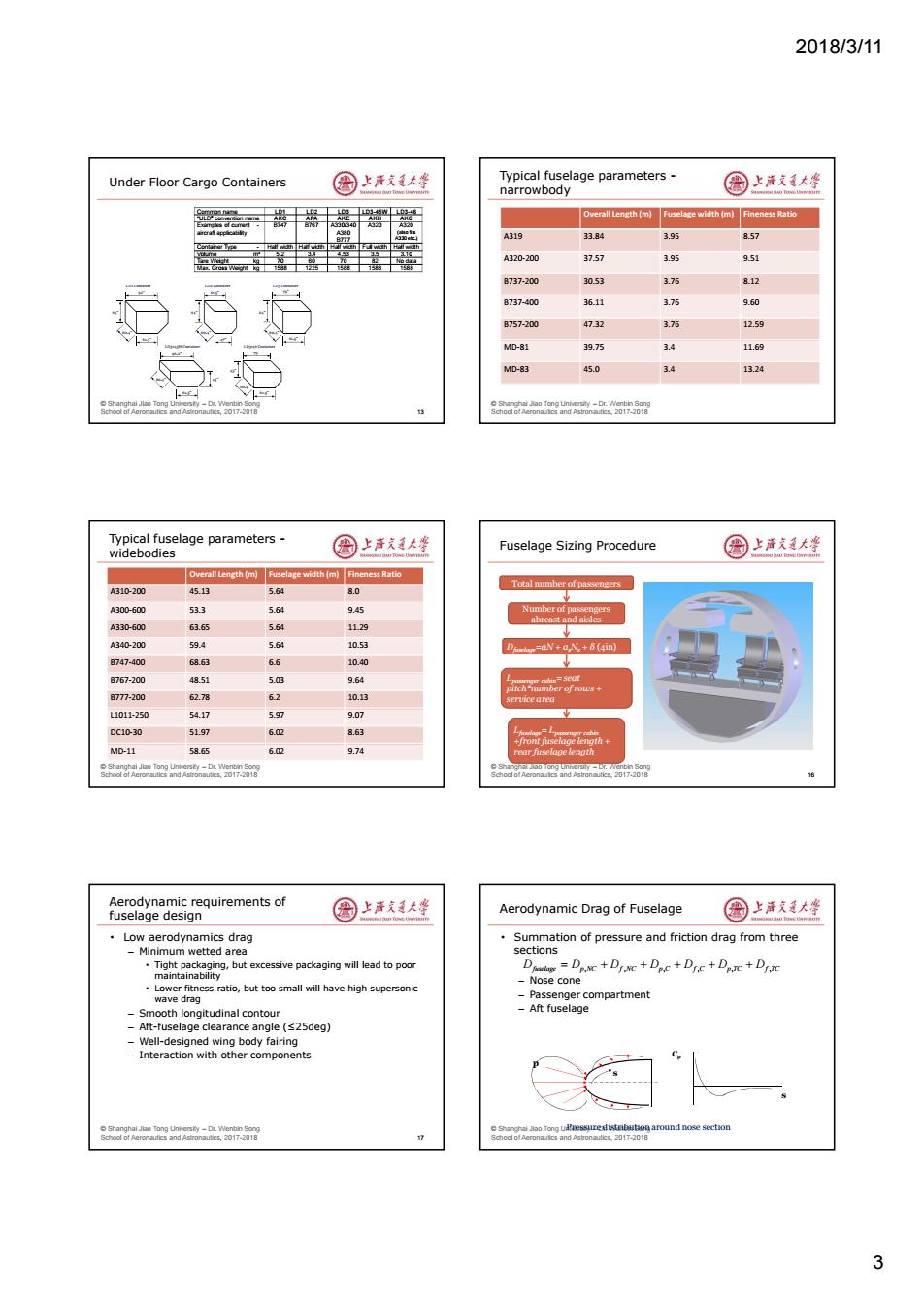
2018/3/11 Under Floor Cargo Containers 圈上声天大学 Typical fuselage parameters narrowbody 国上清大学 是 Overall Length (m)Fuselage width (m)Fineness Ratio A319 33.84 3.95 8.57 A320-2D0 37.57 3.95 951 B737-200 30.53 3.76 812 8737-400 3611 3.76 9.60 B757-200 4732 3.76 12.59 MD-81 39.75 3.4 11.69 MD-83 45.0 3.4 13.24 Soor an0 Typical fuselage parameters- widebodies 圈上清文大坐 Fuselage Sizing Procedure 园上活道大整 Overall Length (m)Fuselage width (m)Fineness Ratio A310-200 45.13 5.64 8.0 Total number of passengers A300-600 53.3 5.64 9.45 A330-600 63.65 5.64 1129 A340-200 59.4 5.64 10.53 =aN+a N.+6 (4in) B747-400 68.63 6.6 10.40 业 B767-200 4851 5.03 9.64 itch number of rows+ 8777-200 62.78 62 10.13 1011-250 54.17 5.97 9.07 Dc1030 51.97 6.02 8.63 MD-11 58.65 6.02 9.74 rear furselage length Aerodynamic requirements of fuselage design 国上清大学 Aerodynamic Drag of Fuselage 园上海发大坐 Low aerodynamics drag Summation of pressure and friction drag from three -Minimum wetted area sections Tight packaging,but excessive packaging will lead to poor D DANc+DIE+Dne+DiE+Dpc+Dye maintainability -Nose cone Lower fitness ratio,but too small will have high supersonic wave drag -Passenger compartment -Smooth longitudinal contour Aft fuselage Aft-fuselage clearance angle (s25deg) Well-designed wing body fairing -Interaction with other components 3
2018/3/11 3 © Shanghai Jiao Tong University – Dr. Wenbin Song School of Aeronautics and Astronautics, 2017-2018 Under Floor Cargo Containers 13 Common name LD1 LD2 LD3 LD3-45W LD3-46 “ULD” convention name AKC APA AKE AKH AKG Examples of current aircraft applicability - B747 B767 A330/340 A380 B777 A320 A320 (also fits A330 etc.) Container Type - Half width Half width Half width Full width Half width Volume m³ 5.2 3.4 4.53 3.5 3.10 Tare Weight kg 70 60 70 82 No data Max. Gross Weight kg 1588 1225 1588 1588 1588 61.5” LD1 Container 60.4” 64” 92” 47” LD2 Container 60.4” 64” 61.5” 61.5” LD3 Container 60.4” 64” 79” 45” 61.5” LD3-46 Container 60.4” 45” 79” 61.5” LD3-45W Container 60.4” 96.2” © Shanghai Jiao Tong University – Dr. Wenbin Song School of Aeronautics and Astronautics, 2017-2018 Typical fuselage parameters - narrowbody Overall Length (m) Fuselage width (m) Fineness Ratio A319 33.84 3.95 8.57 A320-200 37.57 3.95 9.51 B737-200 30.53 3.76 8.12 B737-400 36.11 3.76 9.60 B757-200 47.32 3.76 12.59 MD-81 39.75 3.4 11.69 MD-83 45.0 3.4 13.24 © Shanghai Jiao Tong University – Dr. Wenbin Song School of Aeronautics and Astronautics, 2017-2018 Typical fuselage parameters - widebodies Overall Length (m) Fuselage width (m) Fineness Ratio A310-200 45.13 5.64 8.0 A300-600 53.3 5.64 9.45 A330-600 63.65 5.64 11.29 A340-200 59.4 5.64 10.53 B747-400 68.63 6.6 10.40 B767-200 48.51 5.03 9.64 B777-200 62.78 6.2 10.13 L1011-250 54.17 5.97 9.07 DC10-30 51.97 6.02 8.63 MD-11 58.65 6.02 9.74 © Shanghai Jiao Tong University – Dr. Wenbin Song School of Aeronautics and Astronautics, 2017-2018 Fuselage Sizing Procedure 16 Total number of passengers Number of passengers abreast and aisles Dfuselage=aN + asNs + δ (4in) Lpassenger cabin= seat pitch*number of rows + service area Lfuselage= Lpassenger cabin +front fuselage length + rear fuselage length © Shanghai Jiao Tong University – Dr. Wenbin Song School of Aeronautics and Astronautics, 2017-2018 Aerodynamic requirements of fuselage design • Low aerodynamics drag – Minimum wetted area • Tight packaging, but excessive packaging will lead to poor maintainability • Lower fitness ratio, but too small will have high supersonic wave drag – Smooth longitudinal contour – Aft-fuselage clearance angle (≤25deg) – Well-designed wing body fairing – Interaction with other components 17 © Shanghai Jiao Tong University – Dr. Wenbin Song School of Aeronautics and Astronautics, 2017-2018 Aerodynamic Drag of Fuselage • Summation of pressure and friction drag from three sections – Nose cone – Passenger compartment – Aft fuselage Cp s s p Pressure distribution around nose section D D D D D D D fuselage p NC f NC p C f C p TC f TC , , , , ,
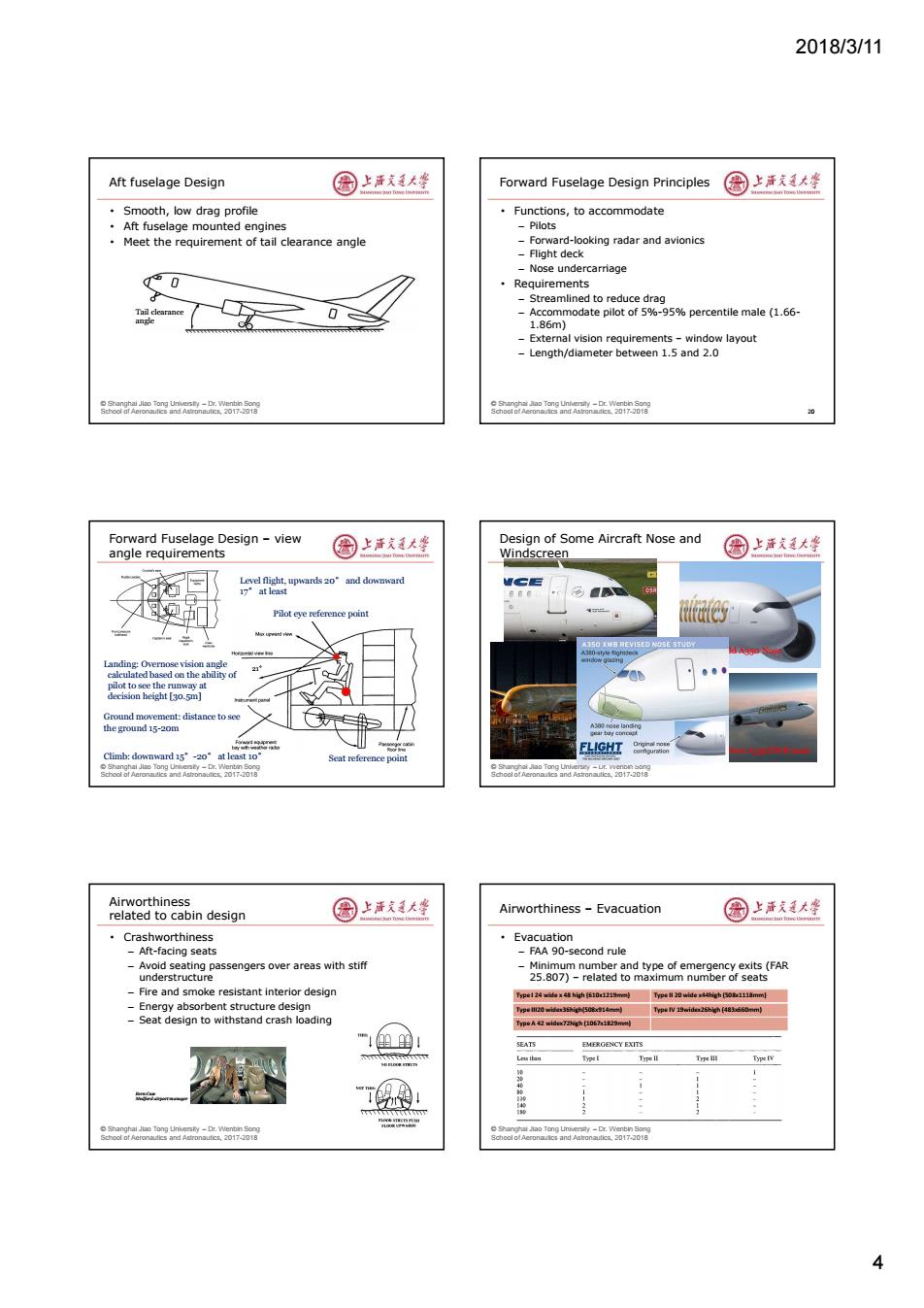
2018/3/11 Aft fuselage Design 因上声天大学 Forward Fuselage Design Principles 国上清大学 Smooth,low drag profile Functions,to accommodate Aft fuselage mounted engines -Pilots Meet the requirement of tail clearance angle Forward-looking radar and avionics Flight deck -Nose undercarriage 0 ·Requirements Streamlined to reduce drag 0 Accommodate pilot of 5%-95%percentile male (1.66- 1.86m】 -External vision requirements-window layout Length/diameter between 1.5 and 2.0 o r nd 0171 hool and Forward Fuselage Design -view Design of Some Aircraft Nose and angle requirements 圈上活大坐 Windscreen 园上活道大整 Pilot eye reference point A350 XWB REVISED NOSE STUD sed on the ability of "ab Ground movement:distance to se the ground 15-2om Climb:downward 15"-20at least io ELGH虹 Seat reference point Airworthiness related to cabin design 国上清大学 Airworthiness -Evacuation 园上海发大坐 Crashworthiness ·Evacuation -Aft-facing seats FAA 90-second rule -Avoid seating passengers over areas with stiff -Minimum number and type of emergency exits (FAR understructure 25.807)-related to maximum number of seats Fire and smoke resistant interior design Energy absorbent structure design Type ll20 widershig(50814mm) Type IV 19widex26high (483560mm) Seat design to withstand crash loading SEATS EMERGENCY EXITS Leu than T区i Type lv 4
2018/3/11 4 © Shanghai Jiao Tong University – Dr. Wenbin Song School of Aeronautics and Astronautics, 2017-2018 Aft fuselage Design • Smooth, low drag profile • Aft fuselage mounted engines • Meet the requirement of tail clearance angle Tail clearance angle © Shanghai Jiao Tong University – Dr. Wenbin Song School of Aeronautics and Astronautics, 2017-2018 Forward Fuselage Design Principles • Functions, to accommodate – Pilots – Forward-looking radar and avionics – Flight deck – Nose undercarriage • Requirements – Streamlined to reduce drag – Accommodate pilot of 5%-95% percentile male (1.66- 1.86m) – External vision requirements – window layout – Length/diameter between 1.5 and 2.0 20 © Shanghai Jiao Tong University – Dr. Wenbin Song School of Aeronautics and Astronautics, 2017-2018 Forward Fuselage Design – view angle requirements Seat reference point Pilot eye reference point 21° Landing: Overnose vision angle calculated based on the ability of pilot to see the runway at decision height [30.5m] Level flight, upwards 20° and downward 17° at least Ground movement: distance to see the ground 15-20m Climb: downward 15°-20° at least 10° © Shanghai Jiao Tong University – Dr. Wenbin Song School of Aeronautics and Astronautics, 2017-2018 Design of Some Aircraft Nose and Windscreen New A350XWB nose Old A350 Nose © Shanghai Jiao Tong University – Dr. Wenbin Song School of Aeronautics and Astronautics, 2017-2018 Airworthiness related to cabin design • Crashworthiness – Aft-facing seats – Avoid seating passengers over areas with stiff understructure – Fire and smoke resistant interior design – Energy absorbent structure design – Seat design to withstand crash loading Bern Case Medford airport manager © Shanghai Jiao Tong University – Dr. Wenbin Song School of Aeronautics and Astronautics, 2017-2018 Airworthiness – Evacuation • Evacuation – FAA 90-second rule – Minimum number and type of emergency exits (FAR 25.807) – related to maximum number of seats Type I 24 wide x 48 high (610x1219mm) Type II 20 wide x44high (508x1118mm) Type III20 widex36high(508x914mm) Type IV 19widex26high (483x660mm) Type A 42 widex72high (1067x1829mm)
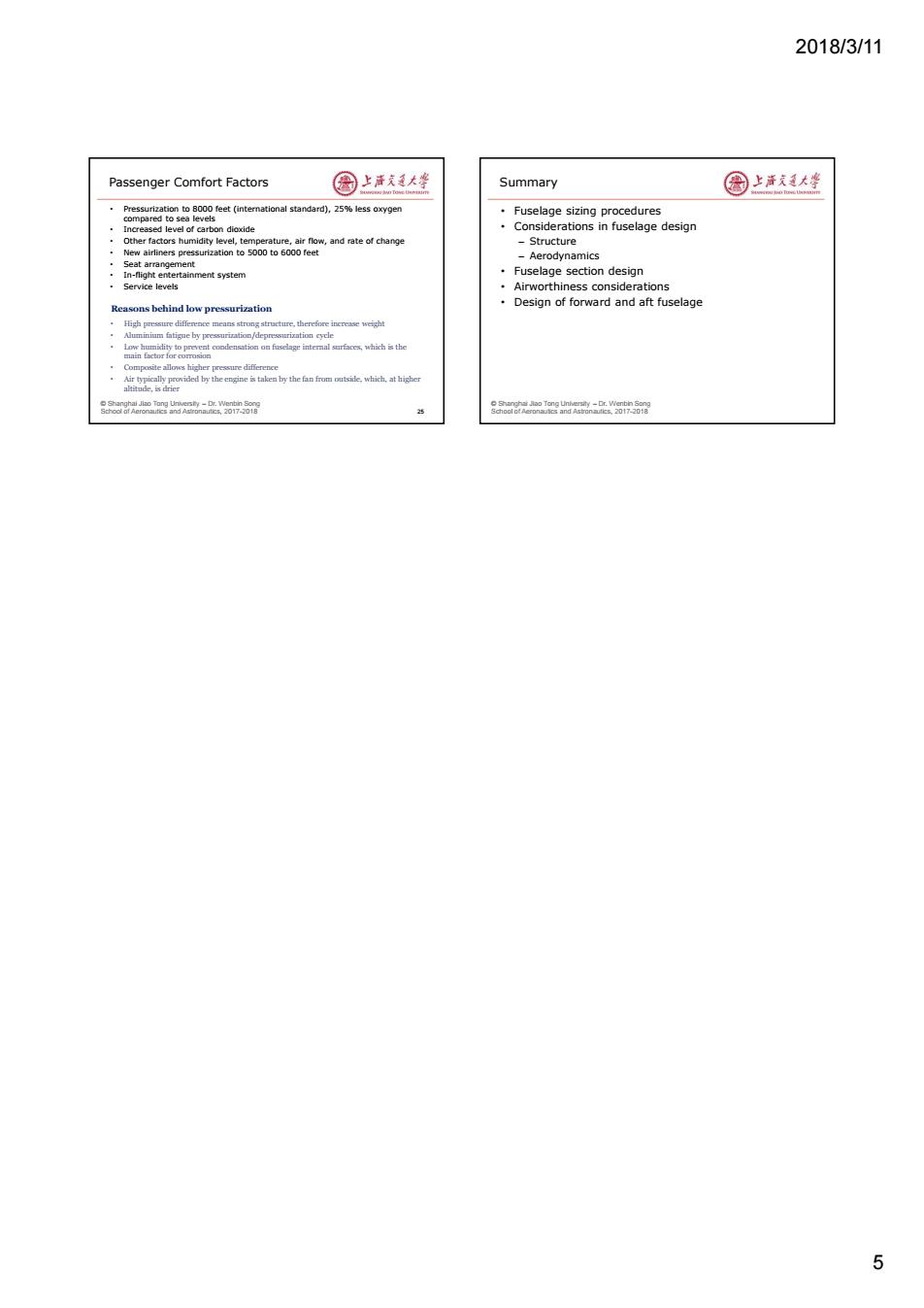
2018/3/11 Passenger Comfort Factors 园上声克通大警 Summary 国上清大学 Pressurization to 8000 feet(intemational standard),25%less oxygen compared to sea levels Fuselage sizing procedures Increased level of carbon dioxide Considerations in fuselage design Other factors humidity level,temperature,air flow,and rate of change Structure New airliners pressurization to 5000 to 6000 feet -Aerodynamics In-flight entertainment system Fuselage section design Service levels Airworthiness considerations Reasons behind low pressurization Design of forward and aft fuselage High pressure difference means strong structure,therefore inerease weight ovided by istaken by the fan from which.at higher Soor an0 5
2018/3/11 5 © Shanghai Jiao Tong University – Dr. Wenbin Song School of Aeronautics and Astronautics, 2017-2018 Passenger Comfort Factors • Pressurization to 8000 feet (international standard), 25% less oxygen compared to sea levels • Increased level of carbon dioxide • Other factors humidity level, temperature, air flow, and rate of change • New airliners pressurization to 5000 to 6000 feet • Seat arrangement • In-flight entertainment system • Service levels 25 • High pressure difference means strong structure, therefore increase weight • Aluminium fatigue by pressurization/depressurization cycle • Low humidity to prevent condensation on fuselage internal surfaces, which is the main factor for corrosion • Composite allows higher pressure difference • Air typically provided by the engine is taken by the fan from outside, which, at higher altitude, is drier Reasons behind low pressurization © Shanghai Jiao Tong University – Dr. Wenbin Song School of Aeronautics and Astronautics, 2017-2018 Summary • Fuselage sizing procedures • Considerations in fuselage design – Structure – Aerodynamics • Fuselage section design • Airworthiness considerations • Design of forward and aft fuselage